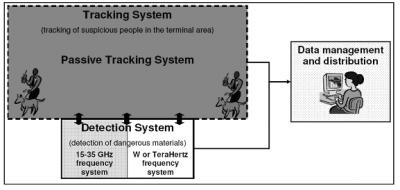Airport Detection and Tracking of Dangerous Materials (ATOM)
The ATOM project is supported through the European Commission's 7th Framework Programme as a capability project in the area of airport security. The full title "Airport detection and Tracking Of dangerous Materials by passive and active sensors arrays " expresses clearly the goal and means of the project. The project will design and develop an innovative detection and surveillance system able to enhance the security level both of the terminal and of the gate area and of the airport, thanks to its capability of detecting hidden hazardous materials/tools and tracking the movements of people bringing these materials; while directly enhancing the airport security, the ATOM system will also indirectly contribute to protect aircraft from terrorist or other criminal acts. The ATOM system will be a non-intrusive but pervasive security system, based on the integration of active and passive radar technology (see Figure below). The project started on July 1, 2009 and it should last for three years.
The Consortium is led by SESM s.c.a.r.l. of a Finmeccanica Company (Italy) and it consists of Schiphol Airport (The Netherlands) and Targu Mures Airport (Romania) as end users, Dept. of Information and Communication Science and Technique - "Sapienza" University of Rome (INFOCOM, Italy), Die Forschungsgesellschaft f�r Angewandte Naturwissenschaften e.V. (FGAN, Germany) and Delft University of Technology (TUD, The Netherlands) as knowledge institutes, Thales Nederland B.V. (TNL, The Netherlands) and Hellenic Aerospace Industry (HAI, Greece) as industrial partners, Slot Consulting Ltd. (SLOT, Hungary), Ayco Internet S.L. (AYCO, Spain) and Link s.r.l. (LINK, Italy) as small enterprises.

Main blocks of the ATOM system
MTSR on behalf of TUD contributes to this project with the development of an ultra-wideband (UWB) radar technology that provides a high 3-D imaging capability and performs shape-based detection of concealed dangerous objects such as metallic weapons and explosive materials. A concept of imaging sensor operating within a 15-35 GHz band will be developed and tested along with advanced signal processing for the precise localization and extraction of features of the dangerous objects.

Image of mannequin with a gun obtained by UWB.
For more information, see the project homepage.

Project data
| Researchers: | Olexander Yarovoy, T.G. Savelyev, Xiaodong Zhuge, Pascal Aubry |
|---|---|
| Starting date: | July 2009 |
| Closing date: | July 2012 |
| Sponsor: | FP7 |
| Partners: | Finmeccanica (Italy), Schiphol Airport (The Netherlands), Targu Mures Airport (Romania), "Sapienza" University of Rome (INFOCOM, Italy), FGAN (Germany), TU Delft, Thales Nederland (The Netherlands), Hellenic Aerospace Industry (Greece), Slot Consulting (Hu |
| Contact: | Olexander Yarovoy |